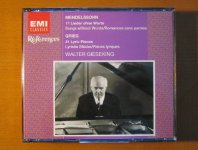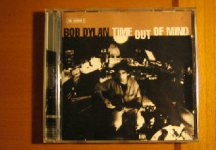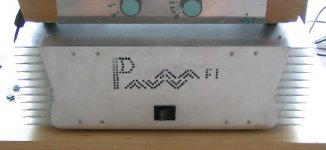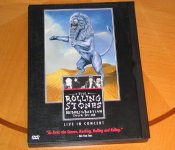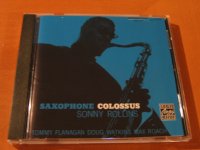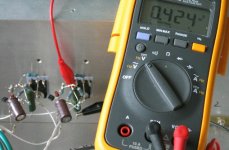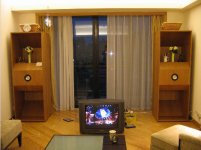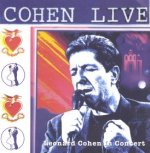It is interesting. J-Low offers very good flexibility.
The single pole high pass filter has developed to 0.1uF+15k at 106Hz. And, I have finally soldered them firmly to the input of the BOSOZ. In addition, I have prepared two resistors of 22K and 47K rated at 20W for the R0 in parallel with the driver of J-Low. The R0 has been to get certain effect in Qes and to even out the driver’s impedance peaks. I have preferred 47K to 22K. I have found that the sound has been getting somewhat drier and thinner with 22K.
I have tried these mainly to tune the bass level, considering my W3.7mxH2.7mxD8m room.
At my normal listening level, this BOSOZ/F1/J-Low system does not offer the body-massaging bass. But, they offer deep, wide and clean bass fully filled in my room so that I can imagine the deep and wide space of the music stage. I don’t need any room tuning. Yeah . . . this is a good merit I can be rewarded by this system. Whenever I want, I can tune the bass level, and with no consideration of any additional head-ache room tuning for different room sizes.
Easy, smooth, sweet and warm . . . among other undesirable things if any.

Regards
jH
The single pole high pass filter has developed to 0.1uF+15k at 106Hz. And, I have finally soldered them firmly to the input of the BOSOZ. In addition, I have prepared two resistors of 22K and 47K rated at 20W for the R0 in parallel with the driver of J-Low. The R0 has been to get certain effect in Qes and to even out the driver’s impedance peaks. I have preferred 47K to 22K. I have found that the sound has been getting somewhat drier and thinner with 22K.
I have tried these mainly to tune the bass level, considering my W3.7mxH2.7mxD8m room.
At my normal listening level, this BOSOZ/F1/J-Low system does not offer the body-massaging bass. But, they offer deep, wide and clean bass fully filled in my room so that I can imagine the deep and wide space of the music stage. I don’t need any room tuning. Yeah . . . this is a good merit I can be rewarded by this system. Whenever I want, I can tune the bass level, and with no consideration of any additional head-ache room tuning for different room sizes.
Easy, smooth, sweet and warm . . . among other undesirable things if any.
Regards
jH
jh6you said:In addition, I have prepared two resistors of 22K and 47K rated at 20W for the R0 in parallel with the driver of J-Low. The R0 has been to get certain effect in Qes and to even out the driver’s impedance peaks. I have preferred 47K to 22K. I have found that the sound has been getting somewhat drier and thinner with 22K.
Aya . . . sorry for the typing error.
Not 22K and 47K, but 22 and 47.
Regards
jH
One more trial . . . 33R for R0, and finally soldered it into the firm fixation.
Hmm . . . now it seems that the bass tuning is done to my taste.
My taste? I do not pursuit the body-massaging bass. Occasionally, I might want to have body-massage, and I could have. It is, however, good only for short time--no more than 20 minutes. Longer? I just start to get a pain.
I love deep, wide and clean bass notes in good amount.
Playing the BOSOZ/F1/J-Low system, I have got the deep, wide and clean bass notes in good amount, surprisingly not by more digging in the lowest frequency, but by finding a proper roll-off in the low frequencies. It might sound strange to you.
Regards
jH
Mendelssohn, 17 Songs without Words
Grieg, 31 Lyric Pieces
Walter Gieseking
When I am weary and feeling small . . .
This music is a fresh drink . . .
The J-Low offers overflow of fresh drinks . . .
Hmm . . . now it seems that the bass tuning is done to my taste.
My taste? I do not pursuit the body-massaging bass. Occasionally, I might want to have body-massage, and I could have. It is, however, good only for short time--no more than 20 minutes. Longer? I just start to get a pain.
I love deep, wide and clean bass notes in good amount.
Playing the BOSOZ/F1/J-Low system, I have got the deep, wide and clean bass notes in good amount, surprisingly not by more digging in the lowest frequency, but by finding a proper roll-off in the low frequencies. It might sound strange to you.
Regards
jH
Mendelssohn, 17 Songs without Words
Grieg, 31 Lyric Pieces
Walter Gieseking
When I am weary and feeling small . . .
This music is a fresh drink . . .
The J-Low offers overflow of fresh drinks . . .
Attachments
metalman said:
Damn you Nelson Pass!!! Before I found passdiy.com I was content with my ignorance and mediocre sounding stereo system. No one warned me that this hobby is an infectious disease causing a slow spiral into insanity. I spend way too much time now giggling uncontrollably while surrounded by electronics paraphenalia, murmering about the search for the ultimate circuit.
Ultimate . . . Phew . . .
Here is what I'm trying at the same time:
1. Variation of high pass single pole filter at the input of BOSOZ
2. Variation of bias current of F1
3. Variation of active current gain of F1
4. Variation of stuffing J-Low
5. Variation of resistor values in parallel with JX92S
Wao . . . already five items. And if each item has five variations, total . . . wao . . . It's a long and winding road. It might take minimum one year . . .



Anyhow . . . it's fun.
Hi Nelson,
I have one question. While I understand that mosfets like higher Drain voltages, I can not understand why they like higher bias current too. Simply for low distortion . . .? It depends . . .? Could you give me a brief explanation?
For your info. at present I set the bias current of F1 down to 1.093617A (active current gain is about 45%) and kept it few days. The sound is still very good for me. Anyhow, I look forward to hearing from you about your view. Sorry for making you repeat the same(?) answers.
Best Regards
jH
As you increase the bias, you increase the transconductance.
For a given output current, this results in operating over a
more linear region, and the distortion improvement is dramatic.
As you increase the voltage across the Drain and Source, the
capacitance diminishes, and with it the nonlinearity of the
capacitance, resulting in better performance at high frequencies.
Also, the variation of Drain current vs Vds for a given Vgs
declines, making it more linear at low frequencies as well.
This effect is most dramatic at low voltages like 2 volts, and
becomes relatively unimportant at higher voltages like 10 volts
or more. For this reason, I like to leave a few volts left on the
Mosfet at clipping, which is easy to do with follower circuits since
they need 4 or 5 volts Vgs from the drive source anyway, and
unless you provide a higher supply rail for the front end, the Vds
of the outputs will not be less than about 7 volts or so.

For a given output current, this results in operating over a
more linear region, and the distortion improvement is dramatic.
As you increase the voltage across the Drain and Source, the
capacitance diminishes, and with it the nonlinearity of the
capacitance, resulting in better performance at high frequencies.
Also, the variation of Drain current vs Vds for a given Vgs
declines, making it more linear at low frequencies as well.
This effect is most dramatic at low voltages like 2 volts, and
becomes relatively unimportant at higher voltages like 10 volts
or more. For this reason, I like to leave a few volts left on the
Mosfet at clipping, which is easy to do with follower circuits since
they need 4 or 5 volts Vgs from the drive source anyway, and
unless you provide a higher supply rail for the front end, the Vds
of the outputs will not be less than about 7 volts or so.
Thank you for the clear overall explanation.
Non-linear swing and distortion . . .
Ah . . . um . . . You are terrific! You lock up them safely in the narrow linear zone. That's why my F1 even with the 1A bias (definitely with the Aleph current source) still gives me the same good sound. I am in having been understood of this.
in having been understood of this.
Sometimes I wonder if you are a Jekyll or a Hyde . . .

Regards
jH
Non-linear swing and distortion . . .
Ah . . . um . . . You are terrific! You lock up them safely in the narrow linear zone. That's why my F1 even with the 1A bias (definitely with the Aleph current source) still gives me the same good sound. I am
Sometimes I wonder if you are a Jekyll or a Hyde . . .
Regards
jH
Again, here is what I'm all doing:
1. Variation of gain of BOSOZ
2. Variation of high pass single pole filter at the input of BOSOZ
3. Variation of bias current of F1
4. Variation of active current gain of F1
5. Variation of stuffing J-Low
6. Variation of resistor values in parallel with JX92S
And, here is where I am now:
1.
The gain is slightly more than unity at maximum. This is to get low but enough signal input voltages to the input of the F1 for my home listening. Probably, I could consider a passive pre instead. According to my experience, however, the passive pre in general gives me the sound of clean dry flower. Therefore, I always prefer active pre which could give me the sound of healthy real rose. Another merit from the active pre is that I could switch it to various gains other than unity whenever I want.
2.
I fixed it at 105Hz.
3.
Thanks to Nelson's explanation, now I understand the major role of bias current, and I have got self-confidence in playing with it. I ended up with the bias of 1.093617A as measured across the 0r47 bias resistor. I reached to this point, by adding 75K R between the base of the current source transistor and the plus side of the 220uF bootstrapping cap. The sound is wonderful.
4.
I estimate that I get the current gain at about 45%, which is similar as Aleph 3. I didn't try any other value this time. Based on my experiments earned from the old projects, I see the 45% is within the most optimistic range.
5.
I filled in each chamber with one and a half of the 50cm x 50cm sofa cushion stuffing polyester. To find the suitable stuffing, I tuned it, listening mainly to voices of female singers and voices of movie sound track. This job is most difficult part among others for me. I'm really sweating lot. I might try more variations until I'm sure of the safe arrival near to the desirable quality.
6.
I tried 47R again to compare with 33R. I got a final conclusion with 47R. I brought it inside and soldered it directly to JX92S.
Hm hmmm . . . I hope this info will be useful for you, diyers.
Regards
jH
Bob Dylan, Time Out of Mind
I love . . .
Maybe, too much of sorrow and pain in love . . .
Nevertheless, I like his blues sound . . .
Pulling out from his deep and skar heart . . .
7. Not Dark Yet
The tambourine plays on back side of the stage. The sound is far, but its timbre is very detailed and clear . . .
8. Cold Irons Bound
The electric bass bounces all the way . . .
Pleasently rhythmical . . .
1. Variation of gain of BOSOZ
2. Variation of high pass single pole filter at the input of BOSOZ
3. Variation of bias current of F1
4. Variation of active current gain of F1
5. Variation of stuffing J-Low
6. Variation of resistor values in parallel with JX92S
And, here is where I am now:
1.
The gain is slightly more than unity at maximum. This is to get low but enough signal input voltages to the input of the F1 for my home listening. Probably, I could consider a passive pre instead. According to my experience, however, the passive pre in general gives me the sound of clean dry flower. Therefore, I always prefer active pre which could give me the sound of healthy real rose. Another merit from the active pre is that I could switch it to various gains other than unity whenever I want.
2.
I fixed it at 105Hz.
3.
Thanks to Nelson's explanation, now I understand the major role of bias current, and I have got self-confidence in playing with it. I ended up with the bias of 1.093617A as measured across the 0r47 bias resistor. I reached to this point, by adding 75K R between the base of the current source transistor and the plus side of the 220uF bootstrapping cap. The sound is wonderful.
4.
I estimate that I get the current gain at about 45%, which is similar as Aleph 3. I didn't try any other value this time. Based on my experiments earned from the old projects, I see the 45% is within the most optimistic range.
5.
I filled in each chamber with one and a half of the 50cm x 50cm sofa cushion stuffing polyester. To find the suitable stuffing, I tuned it, listening mainly to voices of female singers and voices of movie sound track. This job is most difficult part among others for me. I'm really sweating lot. I might try more variations until I'm sure of the safe arrival near to the desirable quality.
6.
I tried 47R again to compare with 33R. I got a final conclusion with 47R. I brought it inside and soldered it directly to JX92S.
Hm hmmm . . . I hope this info will be useful for you, diyers.
Regards
jH
Bob Dylan, Time Out of Mind
I love . . .
Maybe, too much of sorrow and pain in love . . .
Nevertheless, I like his blues sound . . .
Pulling out from his deep and skar heart . . .
7. Not Dark Yet
The tambourine plays on back side of the stage. The sound is far, but its timbre is very detailed and clear . . .
8. Cold Irons Bound
The electric bass bounces all the way . . .
Pleasently rhythmical . . .
Attachments
Here is new face plate of F1.
For heat sinks to contact with room air more.
I can touch the sinks with my bare hand more than 5 seconds.
Making the face square is a common rule . . .?
I hope I didn't violate it . . .
F1/J-Low, not picky . . .
Wonderful for different types of music . . .
And for old and new CDs . . .
Good involvement in human sensitivity . . .
Regards
jH
For heat sinks to contact with room air more.
I can touch the sinks with my bare hand more than 5 seconds.
Making the face square is a common rule . . .?
I hope I didn't violate it . . .
F1/J-Low, not picky . . .
Wonderful for different types of music . . .
And for old and new CDs . . .
Good involvement in human sensitivity . . .
Regards
jH
Attachments
Rolling Stones
Bridges to Babylon
Tour '97-'98
I blew off dust and put it on DVD player.
Wow!
F1/J-Low brought up with the stage, players, audiences and heat.
All to my living room.
When Stones walked over the bridge to the small stage in the middle of the audiences,
I jumped down to the ground floor, jumped into a 24-hour shop for beer,
Jumped up to my room, cooled me down, and continued.
Wow!
Rolling Stones!
I will replace X-ZenV2/3-way horn with F1/J-Low for my main system.
Regards
jH
Attachments
I watched the above Rolling Stones DVD several times before, using my old systems. But, I felt really excited particularly this time, during watching it with my new system. Hmm . . . why . . . ?
First of all, it seemed to be due to Mick Jagger’s vocal. When I watched it through my previous system, his vocal was somewhat hard so that I could not stand for long series of his songs and felt early-rising fatigue. Meanwhile, through the new system, I did not realize the hardness in his vocal at all. He was just amazing vocalist cooking old stuffs new.
Second, it seemed to be due to that the new system expanded the sound stage wide, where all performers gave me their details and an amazing harmony merged into a big picture. I did not realize any unacceptable noise.
Third, it seemed to be due to that the excited choir of full audiences was hot. The choir was loud, but wasn’t mixed up into a big noise. It was quite natural choir which was as if to be a big back-chorus.
Finally, it seemed to be due to smoothness and warmth all together. O . . . and sweet . . .
I was really suspicious of the so small belly-button drivers . . .
Regards
jH
For short, I came back home where I have X-Zen V2 and 3way 97dB horn speakers.
While my co-pilot went out shopping to prepare nice diy welcome-home dinner, I momentarily did a simple tweak of the X-Zen V2 to X-Zen, removing the Aleph current source and reducing the bias current down to about 1A. This was to get my own experiment of the first watt sound through the combo of the 3way high efficiency speakers and the X-Zen. (Main difference between X-Zen and F1: X-Zen has resistor tail and is a voltage amp, while F1 has ccs tail and is a current amp.)
I eagerly wanted to see how the sound would change with the X-Zen of no Aleph current source and the reduced bias. Surprisingly, the sound was still loud and wonderful.
It was an exciting experiment . . . and nice diy meal . . .
Wondering how the X-Zen will go with J-Low . . .
Regards
jH
While my co-pilot went out shopping to prepare nice diy welcome-home dinner, I momentarily did a simple tweak of the X-Zen V2 to X-Zen, removing the Aleph current source and reducing the bias current down to about 1A. This was to get my own experiment of the first watt sound through the combo of the 3way high efficiency speakers and the X-Zen. (Main difference between X-Zen and F1: X-Zen has resistor tail and is a voltage amp, while F1 has ccs tail and is a current amp.)
I eagerly wanted to see how the sound would change with the X-Zen of no Aleph current source and the reduced bias. Surprisingly, the sound was still loud and wonderful.
It was an exciting experiment . . . and nice diy meal . . .
Wondering how the X-Zen will go with J-Low . . .
Regards
jH
After having tried on the X-Zen/3way horn at home, I brought this CD to the F1/J-low.
SAXOPHONE COLOSSUS
Sonny Rollins
"***** . . . Rollins displays humor, gentleness, a delicate feeling for beauty . . . " --Ralph J. Gleason, Down Beat
Yeah . . .
I feel his humor and gentleness in his play. Hmm . . . better from the F1/J-low.
In addition, I feel that the quality (timbre) of his saxophone sound is very natural and rich from the F1/J-low. This must be due to the reason that the transience and the harmonics of the fundamental plus overtones are nearly accurate, thanks to the simple elegant F1 and the single drivers.

Regards
jH
SAXOPHONE COLOSSUS
Sonny Rollins
"***** . . . Rollins displays humor, gentleness, a delicate feeling for beauty . . . " --Ralph J. Gleason, Down Beat
Yeah . . .
I feel his humor and gentleness in his play. Hmm . . . better from the F1/J-low.
In addition, I feel that the quality (timbre) of his saxophone sound is very natural and rich from the F1/J-low. This must be due to the reason that the transience and the harmonics of the fundamental plus overtones are nearly accurate, thanks to the simple elegant F1 and the single drivers.

Regards
jH
Attachments
Last part of the listening impression
Bach
Daniil Shafran
Suites for Solo Cello
No.2 d minor, BWV 1008
No.3 C Major, BWV 1009
No.4 Eb Major, BWV 1010
No.5 c minor, BWV 1011
Putting off all fancy cloth, he just focuses himself on one purpose and deeply, deeply, deeply, digs inner side as if to find profound meaning of life hiding at the bottom. I can clearly see him changing pitches pressing the strings against the frets at different positions with his left hand fingers and enthusiastically shoveling with his right hand bowing. This CD is another diamond . . .
Arriving at this kind of shade of emotion soon after I put a CD on a music reproduction system, could I resist praising the wondeful system? I think that the F1/J-Low contributes most here.
Again, thanks, Nelson . . .
Regards
jH
Bach
Daniil Shafran
Suites for Solo Cello
No.2 d minor, BWV 1008
No.3 C Major, BWV 1009
No.4 Eb Major, BWV 1010
No.5 c minor, BWV 1011
Putting off all fancy cloth, he just focuses himself on one purpose and deeply, deeply, deeply, digs inner side as if to find profound meaning of life hiding at the bottom. I can clearly see him changing pitches pressing the strings against the frets at different positions with his left hand fingers and enthusiastically shoveling with his right hand bowing. This CD is another diamond . . .
Arriving at this kind of shade of emotion soon after I put a CD on a music reproduction system, could I resist praising the wondeful system? I think that the F1/J-Low contributes most here.
Again, thanks, Nelson . . .
Regards
jH
Attachments
Likely, the final tuning of the system
J-Low
47R has been finally chosen and soldered in parallel with the driver to smoothen the impedance curve of the driver. Each chamber has been filled with two 50cmx80cmx10cm (pillow inner stuff) polyester.
Pass F1 (voltage amp version)
The bias current has been set to 0.9A (see the picture showing the bias voltage across Source resistor of 0R47). With this low bias current, I get two advantages. First, I get low heat sink temperature rising about 18 deg C above room temperature. Second, I get the input capacitance reduced due to the reduced open loop gain (reduced transconductance) so that I get better quality of top frequencies. But, I get one disadvantage. It is, as Nelson has earlier indicated, that the transconductuce has been reduced. This must imply that the amp gain has been reduced too. To compensate this, I have increased the closed loop gain (and at the same time got the effect of reduced negative feedback).
This kind of low bias current might be not acceptable to the advocators of high bias.
Hi, Nelson
I’m going to make a brief summary and send it to Passdiy Gallary. It might take about one month from now. Are you going to welcome it? Otherwise . . . uh . . . I don’t want to waste time.
Regards
jH
J-Low
47R has been finally chosen and soldered in parallel with the driver to smoothen the impedance curve of the driver. Each chamber has been filled with two 50cmx80cmx10cm (pillow inner stuff) polyester.
Pass F1 (voltage amp version)
The bias current has been set to 0.9A (see the picture showing the bias voltage across Source resistor of 0R47). With this low bias current, I get two advantages. First, I get low heat sink temperature rising about 18 deg C above room temperature. Second, I get the input capacitance reduced due to the reduced open loop gain (reduced transconductance) so that I get better quality of top frequencies. But, I get one disadvantage. It is, as Nelson has earlier indicated, that the transconductuce has been reduced. This must imply that the amp gain has been reduced too. To compensate this, I have increased the closed loop gain (and at the same time got the effect of reduced negative feedback).
This kind of low bias current might be not acceptable to the advocators of high bias.
Hi, Nelson
I’m going to make a brief summary and send it to Passdiy Gallary. It might take about one month from now. Are you going to welcome it? Otherwise . . . uh . . . I don’t want to waste time.
Regards
jH
Attachments
Congrat.....
Wow....Happy to see all finished so fast
I can imagine "how" j-low sound by accidentally but not decide to built, cause that "size"
Here is the story...
I put my handheld philips radio in cupboard, a big medium cupboard and suddenly realize, WOW this is good!! even the small radio speaker sound totally different!
this accident is long2x...before j-low is launch...lol
Now you have the complete....CONGRATULATION
anyway, have u try listen MADREDEUS and Leonard Cohen in your system? two of my favourite acoustic music
single-ended, single-driver, single-minded....lol
Wow....Happy to see all finished so fast
I can imagine "how" j-low sound by accidentally but not decide to built, cause that "size"
Here is the story...
I put my handheld philips radio in cupboard, a big medium cupboard and suddenly realize, WOW this is good!! even the small radio speaker sound totally different!
this accident is long2x...before j-low is launch...lol
Now you have the complete....CONGRATULATION
anyway, have u try listen MADREDEUS and Leonard Cohen in your system? two of my favourite acoustic music
single-ended, single-driver, single-minded....lol
Attachments
- Status
- This old topic is closed. If you want to reopen this topic, contact a moderator using the "Report Post" button.
- Home
- Amplifiers
- Pass Labs
- Let me lite fire - Nelson Pass F1
